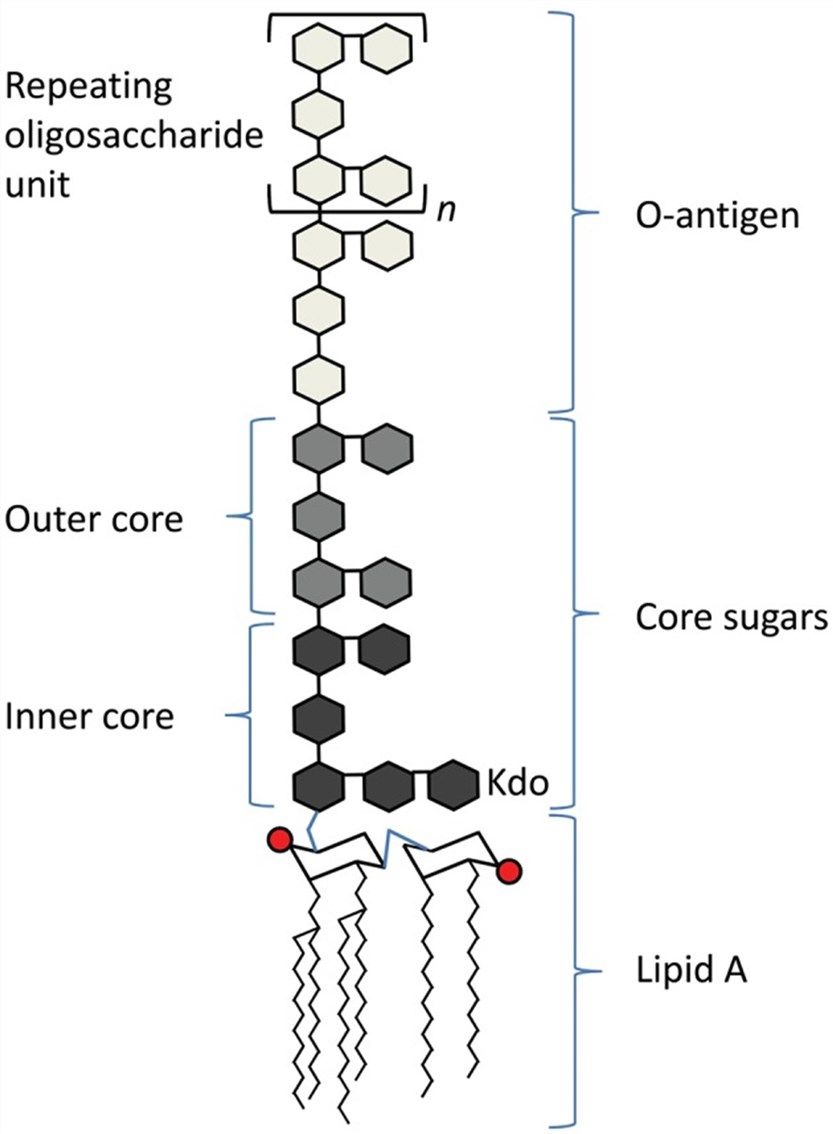



Salmonella typhi infection is spread through the fecal-oral route. Upon ingestion, bacteria traverse the intestinal epithelium, enter the bloodstream, and disseminate systemically. LPS, a gram-negative bacterial virulence factor located in the outer membrane, is one of the primary surface carbohydrates of S. typhi. LPS contains a lipid A tail that anchors it to the membrane, a core oligosaccharide, and an O-antigen side chain. The surface-exposed O-antigen shields the bacterial cell from innate immune responses. S. typhi's O-antigen consists of repeating units of D-Abe-(α1→3)-[D-Man-(α1→4)-L-Rha-(α1→3)-D-Gal-(α1→2)-] tetrasaccharide (Abe denotes abequose (3,6-dideoxy-D-galactose).). Glycosylation and O-acetylation of the O-antigen drive bacterial serological specificity. The O-antigen links to the non-reducing end of the core polysaccharide, and the inner region's 3-deoxy-D-manno-octulosonic acid (Kdo) saccharide connects to the lipid A's glucosamine (GlcN) moiety. The lipid A typically comprises a β-D-GlcN-(1→6)-α-D-GlcN disaccharide with diverse acyl chains and two phosphoryl substituents. The immunogenicity of the O-antigen makes it a potential target for novel vaccines.
 Fig.1 Schematic of the basic structure of LPS. (Maeshima & Fernandez, 2013)
Fig.1 Schematic of the basic structure of LPS. (Maeshima & Fernandez, 2013)
CD BioGlyco utilizes the hot phenol method for the efficient extraction of S. typhi LPS. We treat the crude LPS to minimize the presence of nucleic acids and proteins by using DNase, RNase, and protease. Subsequently, we evaluate the purified LPS by using sodium dodecyl-sulfate polyacrylamide gel electrophoresis (SDS-PAGE) and a distinctive zinc-imidazole staining technique. This meticulous analysis displays a distinct and repetitive band pattern that shows the characteristic of S. typhi LPS.
 Fig.2 The process of S. typhi LPS purification. (CD BioGlyco)
Fig.2 The process of S. typhi LPS purification. (CD BioGlyco)
CD BioGlyco also provides lipid-A free polysaccharide production service. Because lipid A possesses the potential to induce shock and fatal infections caused by gram-negative bacteria. A crucial characteristic of lipid A is the existence of acyl chains, which differ in number and size. These chains are attached to a GlcN-GlcN disaccharide by ester or amide linkages that result in varying levels of toxicity. It is crucial to remove lipid A to ensure safe manipulation of the bacterial surface polysaccharides. We cleave the Kdo-GlcN linkage selectively by subjecting the LPS to mildly acidic conditions, taking advantage of the labile nature of this specific glycosidic bond in LPS. We obtain the lipid-A free polysaccharide by this strategic approach.
We offer lipid-A-free polysaccharide conjugate vaccine against Salmonella. We utilize bacterial Flagellin as a protein carrier for the comjugation. Our methodology utilizes the exposed terminal Kdo saccharide as a precise site for attaching ortho-phenylenediamine and amine linkers. The addition of these linkers is accomplished through a condensation reaction and oxidative amidation, respectively. Subsequently, the polysaccharide-protein conjugates are formed. To characterize the lipid-A free polysaccharide-protein conjugates, we analyze them through SDS-PAGE and fast-performance liquid chromatography (FPLC).
CD BioGlyco is a pioneering biotech company at the forefront of vaccine development. We specialize in the production of polysaccharide antigens through our groundbreaking Glyco™ Vaccine Development Platform. Our expertise lies in the innovative field of Carbohydrate-based Vaccine Development. If you are interested in our services, please don't hesitate to contact us for more additional information.
Reference:
